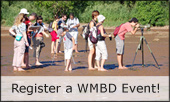|
A Bird's Eye View of Urban Land Use
A Web of Habitats Amongst Expanding Urban Networks
The consistent growth of urban networks disrupts the intricate web of habitats that birds need to complete their migrations. These productive habitats provide food, rest and water at intervals that migratory birds can bridge and therefore are able to replenish their energy reserves for their long migrations.
However, many urban areas have changed considerably from their original state, and dense regions of urban development have resulted in the loss of too many of these connecting habitats, making migration for birds increasingly difficult.

The physical presence of and activities undertaken in urban areas produce light, noise, air and water pollution which make migrations increasingly difficult as well. Noise and light pollution disorient and disrupt migration flights, and polluted air and urban wastewater make the remaining available habitat less productive by damaging local food webs. Physical obstacles such as wind turbines and skyscrapers are also dangerous and collisions with urban structures kill millions of migrating birds a year.
The dense web of urban development in Europe acts as a formidable wall of challenges which migrating birds must navigate through while passing along African-Eurasian flyway. It strains migratory birds’ searches for habitat and too many obstacles may even make regions impassable.
Europe and African Euasian Migrations
Heavily Urbanized Europe Makes Migration Increasingly Difficult

The heavily urbanized areas of Europe threaten migrating birds that travel from breeding grounds in the North to warmer wintering regions in Africa and Asia. Many migrating species also use European habitats for breeding but some only pass through to get to their wintering and breeding grounds.
Yet their brief stay is a crucial part of their migration and some even use the same sites each year.The removal of crucial sites is like removing a stepping stone across a river. Without them, migrating birds cannot fly between their breeding and wintering grounds and cannot survive.
Some migrating birds use shorter lower risk flights with many stops along the chain of habitats they follow to save energy, while others choose longer higher risk flights and fewer stops to travel faster. Urbanization disrupts and strains these strategies by increasing the distance between habitats and making suitable habitats harder to find along the network of sites migratory birds use.

See what migratory birds in your area migrate through heavily urbanized European ares using Wings Over Wetlands (WOW) Critical Site Networking Tool or check out these examples: Eurasian Curlew, Black-tailed Godwit, Corncrake

See "A Bird's Eye View" of heavily Urbanized areas on the WMBD Event Google Map: A Bird's Eye View of Urbanized Europe

Register a WMBD Event
Register a WMBD event to raise awareness about the effects of urbanization on migratory birds in your area and receive WMBD posters and stickers to support your event.
|


